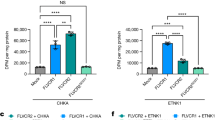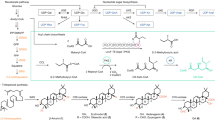Abstract
THE cytotoxicity of the plant lectin ricin, of Ricinus communis seeds, towards mammalian cells is mediated in three steps1. Binding of the toxin to cell surface galactose or N-acetylgalactosamine receptors is followed by entry of the bound lectin into the cells, perhaps by endocytosis2,3 and inhibition of protein synthesis4–6. Several variant lines of cells selected for resistance to ricin have been shown7–10 to bind ricin poorly and to carry much smaller amounts of receptors at the cell surface. We report here that when such a resistant cell line of baby hamster kidney (BHK) fibroblasts8,9 is incubated with a ricin-binding glycolipid fraction prepared from human erythrocytes, glycolipid is taken up and the cells exhibit increased binding of ricin and greater sensitivity to lectin-mediated inhibition of cell protein synthesis. These studies suggest that glycolipids can function in certain circumstances as membrane receptors in the binding of ricin and mediation of ricin cytotoxicity.
This is a preview of subscription content, access via your institution
Access options
Subscribe to this journal
Receive 51 print issues and online access
$199.00 per year
only $3.90 per issue
Buy this article
- Purchase on Springer Link
- Instant access to full article PDF
Prices may be subject to local taxes which are calculated during checkout
Similar content being viewed by others
References
Refsnes, K., Olsnes, S., and Pihl, A., J. biol. Chem., 249, 3557–3562 (1974).
Nicholson, G. L., Nature, 251, 628–630 (1974).
Nicolson, G. L., Lacorbiere, M., and Hunter, T. R., Cancer Res., 35, 144–155 (1974).
Olsnes, S., Naturwissensschaften, 59, 497–502 (1972).
Olsnes, S., and Pihl, A., Biochemistry, 12, 3121–3126 (1973).
Olsnes, S., Fernandez-Puentis, C., Carrasco, L., and Vasquez, D., Eur. J. Biochem., 60, 281–288 (1975).
Gottlieb, C., Skinner, A. M., and Kornfeld, S., Proc. natn. Acad. Sci. U.S.A., 71, 1078–1082 (1974).
Meager, A., Ungkitchanukit, A., Nairn, R., and Hughes, R. C., Nature, 257, 137–139 (1975).
Meager, A., Ungkitchanukit, A., and Hughes, R. C., Biochem. J., 154, 113–124 (1976).
Stanley, P., Caillibot, V., and Siminovitch, L., Somatic Cell Genet., 1, 3–26 (1975).
Gardas, A., and Kosielak, J., Eur. J. Biochem., 32, 178–187 (1973).
Gardas, A., and Kosielak, J., FEBS Lett., 42, 101–104 (1974).
Gardas, A., Eur. J. Biochem., 68, 177–183 (1976).
Surolia, A., Bacchawat, B. K., and Podder, S. K., Nature, 257, 802–803 (1975).
Laine, R. A., and Hakomori, S., Biochem. biophys. Res. Commun., 54, 1039–1045 (1973).
Author information
Authors and Affiliations
Rights and permissions
About this article
Cite this article
HUGHES, R., GARDAS, A. Phenotypic reversion of ricin-resistant hamster fibroblasts to a sensitive state after coating with glycolipid receptors. Nature 264, 63–66 (1976). https://doi.org/10.1038/264063a0
Received:
Accepted:
Issue Date:
DOI: https://doi.org/10.1038/264063a0
This article is cited by
-
Vasectomy
La Ricerca in Clinica e in Laboratorio (1981)
Comments
By submitting a comment you agree to abide by our Terms and Community Guidelines. If you find something abusive or that does not comply with our terms or guidelines please flag it as inappropriate.



